Last year we managed two IPO from investments made in 2016. This was quite exciting as they were the first assets under our management to go through the process.
The first IPO was on TSX Venture Exchange in Canada and the company listed at a share price 35X the original share price our investors invested at. The second was on the prodigious Nasdaq at a £45m valuation (relatively low compared to other big name listings), after our investors had invested at £8m (although some were diluted since 2016 and they did not see the full multiple). Suffice to say, there was a lot of pressure to transfer the shares to the underlying shareholders and let them trade the shares as they saw fit.
We run a nominee in-house. The nominee holds all the shares in the underlying companies on behalf of our investors. Our role during the IPO process is to facilitate signing the numerous documents required, and then to enact a transfer of shares to the underlying shareholders so they can trade the shares as they wish.
Did we get advisors to help? Believe it or not, we didn’t. Our policy at SyndicateRoom is to always take advice where we do not have the right expertise in house. However in each of these cases we read all the legal documents and spoke to the company’s legal team and advisors and it was clear what steps we had to take. Did we mess anything up? I’m glad to say we didn’t, although there are things we could’ve improved. Here are the lessons we gathered from the experience.
Get ahead of the process
It is critical to do everything possible to ensure the transfer happens as soon as possible. Public shares change value daily, and investors need access to the shares so they can sell them if they wish to, assuming the lock-up rules allow it. you need to get ahead of the process – know all the steps involved and map it all out.
We found the IPO process for each company to be quite different. This is very likely due to the fact that they were indeed different companies with their own capital structures, and because one IPO’d on Nasdaq, and one IPO’d on TSX Venture Exchange in Canada. As a UK company investing in UK companies, we weren’t expecting this and had to get on top of the process.
Don’t make any assumptions, and do the boring work. Read the documents and map out the steps and timings. Make sure you understand the lead time for completing any steps. In our case this involved going to the underlying investors to request permission to sign legal documents, but also working with the transfer agents to ensure they received all the necessary documents.
In the case of the Canadian IPO, we could only complete the transfer after the IPO. If you want to transfer North American securities you need Medallion Signature Guarantees, which is provided by a firm with legal authority to authorise the documents. Since we had over 50 transfers to make, we needed a good lead on getting the forms completed and providing all the legal documents required for a Medallion Signature Guarantee.
In the case of the Nasdaq IPO, we had to get 55 signatures from investors in just two days or the whole transfer would fail. We did it. But it involved me getting on my laptop and phone whilst on leave and using every avenue we had to contact the last few investors.
Communication is key
In 2019 I was doing some research on Crowdcube’s investment flow and so I happen to own shares in Digital Brands through Crowdcube which IPO’d on NASDAQ in May 2021. Sadly, the shares are worth a fraction of what I paid for them but worse, the first communication I received about it was after the IPO had already happened. The transfer of shares to me then only began in February 2022. I’m not sharing this to take a shot at Crowdcube, but to highlight that you cannot leave informing investors about the process that late. It has to start as soon as you are notified about even the intentions to IPO. I’m happy to say that we did this, but did not give as many regular updates as we could have.
It’s easy to get caught up in the process and become completely focused on executing the necessary steps without providing regular updates to investors. All the while, investors have heard that an IPO is happening and start to get excited about it, but also nervous that something will fall through. This last part is crucial – the main piece of information clients want is to know where they are in the process. No-one wants to feel like it’s not being handled.
I think this was probably our biggest failing - we could’ve given more regular updates and timelines to investors. In some cases, we were unfortunately not in control of the timings because the company had to sort our internal documents, and the transfer agent was unfamiliar with our setup and we were stuck chasing them for updates and forms. We were also constantly waiting on the company for more information about progress on their end. But we still should’ve done more to lay out the process from the start and give updates as key milestones were hit.
Understand lock-up periods and fees
When you read about IPOs, it’s easy to assume that all shareholders can just go ahead and trade shares. This is not the case in the majority of cases. Company insiders, which often includes early shareholders, are subject to lock-up periods during which they cannot trade the shares. The purpose of this is to prevent a rush on selling shares as these investors look to realise their gains, which can cause a decline in the share price.
Depending on the experience of the underlying shareholders, they may not be aware of this. As the manager, part of the project is to understand which sets of shares will become available when, and making the release schedule clear to shareholders. The company going through the IPO does not always lay it out and can be buried in the legals (which, as explained, you need to read!). In our cases, the one IPO had 25% of shares released at a time over a 18 month period, and the second had a full lockup of trading for 180 days from the point of listing.
Another somewhat hidden aspect is fees. Not all of the listing will have fees for investors, but in our case there were transaction fees coming from the transfer agent, and the cost of the Medallion Signature Guarantees (over 50 of them). They were not significant in comparison to the total amount being transferred, but they hadn’t been planned for or, again, communicated early.
Even outside of the unusual situations coming from North American listings, investors will need a broker account to deposit shares to and they will incur fees with those brokers and when trading. Not all brokers can be used either - only some brokers are able to handle ledger/escrow positions (lockup periods). Again, understanding all the needs and communicating it is extremely important to investors.
Bonus lesson: EIS
Our investors got EIS on their original investment. This was amazing for them, because it meant the investments were free from capital gains tax. Handy if you’re looking at a large return. This applies until you realise the gains, that is, when you sell the shares and not at the point of the IPO. This will be the case for most EIS investments, but not always and you will need to get advice on any particular investment. Moreover, the company going through the IPO will often place a NewCo on top of the original shareholding and they will need to take care there to ensure that the EIS transfers with it.
However, it only applies if you claimed EIS from the original investment. You had to have claimed any EIS, even on just one share, for the whole investment to count. But if you don’t claim then you are subject to normal capital gains, even if you were issued with an EIS3 certificate.
Looking forward
We’ve got at least one portfolio company aiming for an IPO at the end of this year. This one will be in the UK and therefore we expect it to be more straightforward. But we’ll be taking our time to understand the process, lockup periods, and do a much better job of communicating it all.
Find out more about our fund, Access EIS.
Get your copy of our whitepaper

Looking for a fund that does things differently?
Download our whitepaper here, which sets out the uniquely data-driven, co-investment model of our fund, Access EIS.
Register to learn
more about our data,
fund and venture capital





